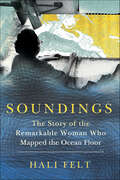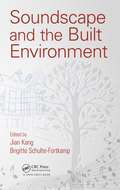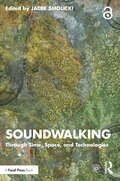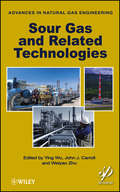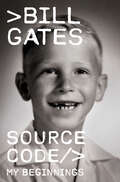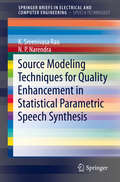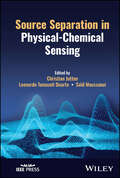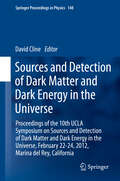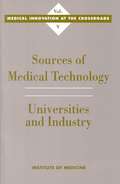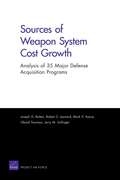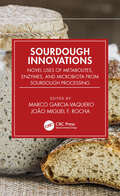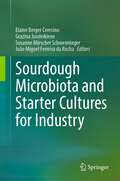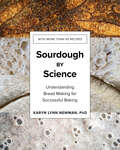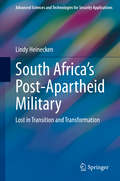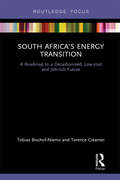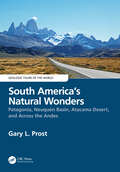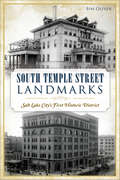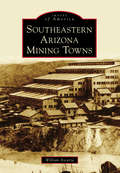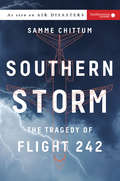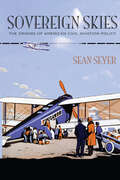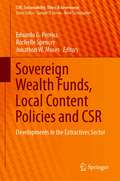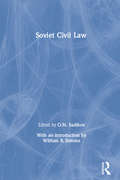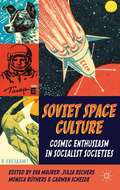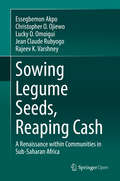- Table View
- List View
Soundings: The Story of the Remarkable Woman Who Mapped the Ocean Floor
by Hali Felt“A fascinating account of a woman working without much recognition . . . to map the ocean floor and change the course of ocean science.” —San Francisco ChronicleSoundings is the story of the enigmatic woman behind one of the greatest achievements of the 20th century. Before Marie Tharp, geologist and gifted draftsperson, the whole world, including most of the scientific community, thought the ocean floor was a vast expanse of nothingness. In 1948, at age 28, Marie walked into the geophysical lab at Columbia University and practically demanded a job. The scientists at the lab were all male. Through sheer willpower and obstinacy, Marie was given the job of interpreting the soundings (records of sonar pings measuring the ocean’s depths) brought back from the ocean-going expeditions of her male colleagues. The marriage of artistry and science behind her analysis of this dry data gave birth to a major work: the first comprehensive map of the ocean floor, which laid the groundwork for proving the then-controversial theory of continental drift.Marie’s scientific knowledge, her eye for detail and her skill as an artist revealed not a vast empty plane, but an entire world of mountains and volcanoes, ridges and rifts, and a gateway to the past that allowed scientists the means to imagine how the continents and the oceans had been created over time.Hali Felt brings to vivid life the story of the pioneering scientist whose work became the basis for the work of others scientists for generations to come.“Felt’s enthusiasm for Tharp reaches the page, revealing Tharp, who died in 2006, to be a strong-willed woman living according to her own rules.” —The Washington Post
Soundscape and the Built Environment
by Jian KangSoundscape Basics and Practical ImplicationsSoundscape research represents a paradigm shift, as it involves human and social sciences and physical measurements to account for the diversity of soundscapes across countries and cultures. Moreover, it treats environmental sounds as a resource rather than a waste. Soundscape and the Built Environment is the first book to systematically discuss soundscape in the built environment. It begins with a presentation of theory and basic background, answering questions such as: what is soundscape, how is it important, and how does it affect people in terms of their health and perception on the acoustic environment. The book then sets out tools for implementing a soundscape approach, with measurement techniques, mapping, and good soundscape practices. It also delivers a series of examples of the application of the soundscape approach in planning, design, and assessment. Discusses soundscape and environmental noise Explores cultural variations and the way they influence soundscape Introduces binaural measurement technology and psychoacoustics Examines the physical, psychological, and physiological restorative mechanism of high-quality acoustic environments Presents soundscape mapping based on human perception of sound sources Includes real-world examples and case studies highlighting the key issues in soundscape intervention Soundscape and the Built Environment is written by a group of leading international figures and derives from a four-year EU COST project on Soundscapes of European Cities and Landscapes. It presents a consensus on the current state of the art and is not merely a collection of different views. It is written for acoustic consultants, urban planners, designers and policy makers, as well as for graduate students and researchers.
Soundwalking: Through Time, Space, and Technologies
by Jacek SmolickiSoundwalking brings together a diverse group of contemporary scholars, artists and thinkers in one of the first comprehensive studies of soundwalking – the practice of moving through space while carefully listening to what it has to say – to address urgent challenges and concerns of an environmental, ethical, social and technological nature. Besides gaining insight into the historical development of soundwalking as a scholarly method and artistic genre, the reader will have a chance to learn from emerging voices concerned with this practice, of many different backgrounds and positionalities. Soundwalking demonstrates how attentive listening and walking might help with more careful and responsible navigation through the complex dimensions of our shared environments and entangled histories, often imperceptible on a day-to-day basis. The book encourages scholars, artists, and also those unfamiliar with the concept, to engage with it in their respective fields and subjects of interest as an interdisciplinary method of critical inquiry and a creative mode of communication. This book inspires readers to discover anew the potential of walking and listening, and will be of interest to students, researchers and practitioners in the areas of studies directly concerned with sound and beyond, including environmental humanities, arts, design, landscape architecture, media, and cultural studies.
Sour Gas and Related Technologies
by John J. Carroll Ying Wu Weiyao ZhuCarbon dioxide has been implicated in the global climate change, and CO2 sequestration is a technology being explored to curb the anthropogenic emission of CO2 into the atmosphere.<P><P> The injection of CO2 for enhanced oil recovery (EOR) has the duel benefit of sequestering the CO2 and extending the life of some older fields. This volume presents some of the latest information on these processes covering physical properties, operations, design, reservoir engineering, and geochemistry for AGI and the related technologies.
Source Code: My Beginnings
by Bill GatesThe origin story of one of the most influential and transformative business leaders and philanthropists of the modern age The business triumphs of Bill Gates are widely known: the twenty-year-old who dropped out of Harvard to start a software company that became an industry giant and changed the way the world works and lives; the billionaire many times over who turned his attention to philanthropic pursuits to address climate change, global health, and U.S. education. Source Code is not about Microsoft or the Gates Foundation or the future of technology. It&’s the human, personal story of how Bill Gates became who he is today: his childhood, his early passions and pursuits. It&’s the story of his principled grandmother and ambitious parents, his first deep friendships and the sudden death of his best friend; of his struggles to fit in and his discovery of a world of coding and computers in the dawn of a new era; of embarking in his early teens on a path that took him from midnight escapades at a nearby computer center to his college dorm room, where he sparked a revolution that would change the world. Bill Gates tells this, his own story, for the first time: wise, warm, revealing, it&’s a fascinating portrait of an American life.
Source Code: My Beginnings
by Bill GatesNamed one of the Most Anticipated Releases of 2025 by The New York Times, The Times, Financial Times and BBC. <p> The origin story of one of the most influential and transformative business leaders and philanthropists of the modern age. The business triumphs of Bill Gates are widely known: the twenty-year-old who dropped out of Harvard to start a software company that became an industry giant and changed the way the world works and lives; the billionaire many times over who turned his attention to philanthropic pursuits to address climate change, global health, and U.S. education. <p> Source Code is not about Microsoft or the Gates Foundation or the future of technology. It’s the human, personal story of how Bill Gates became who he is today: his childhood, his early passions and pursuits. It’s the story of his principled grandmother and ambitious parents, his first deep friendships and the sudden death of his best friend; of his struggles to fit in and his discovery of a world of coding and computers in the dawn of a new era; of embarking in his early teens on a path that took him from midnight escapades at a nearby computer center to his college dorm room, where he sparked a revolution that would change the world. Bill Gates tells this, his own story, for the first time: wise, warm, revealing, it’s a fascinating portrait of an American life. <b>New York Times Bestseller</b>
Source Modeling Techniques for Quality Enhancement in Statistical Parametric Speech Synthesis (SpringerBriefs in Speech Technology)
by K. Sreenivasa Rao N. P. NarendraThis book presents a statistical parametric speech synthesis (SPSS) framework for developing a speech synthesis system where the desired speech is generated from the parameters of vocal tract and excitation source. Throughout the book, the authors discuss novel source modeling techniques to enhance the naturalness and overall intelligibility of the SPSS system. This book provides several important methods and models for generating the excitation source parameters for enhancing the overall quality of synthesized speech. The contents of the book are useful for both researchers and system developers. For researchers, the book is useful for knowing the current state-of-the-art excitation source models for SPSS and further refining the source models to incorporate the realistic semantics present in the text. For system developers, the book is useful to integrate the sophisticated excitation source models mentioned to the latest models of mobile/smart phones.
Source Separation in Physical-Chemical Sensing (IEEE Press)
by Leonardo Tomazeli Duarte Christian Jutten Saïd MoussaouiSource Separation in Physical-Chemical Sensing Master advanced signal processing for enhanced physical and chemical sensors with this essential guide In many domains (medicine, satellite imaging and remote sensing, food industry, materials science), data is obtained from large sets of physical/chemical sensors or sensor arrays. Such sophisticated measurement techniques require advanced and smart processing for extracting useful information from raw sensing data. Usually, sensors are not very selective and record a mixture of the useful latent variables. An innovative technique called Blind Source Separation (BSS) can isolate and retrieve the individual latent variables from a mixed-source data array, allowing for refined analysis that fully exploits these cutting-edged imaging and signal-sensing technologies. Source Separation in Physical-Chemical Sensing, supplies a thorough introduction to the principles of BSS, main methods and algorithms and its potential applications in various domains where data are obtained through physical or chemical sensors. Designed to bridge the gap between chemical/physical analysis and signal processing, it promises to be invaluable in many fields. Its alertness to the latest technologies and the full range of potential BSS applications make it an indispensable introduction to this cutting-edge method. Source Separation in Physical-Chemical Sensing readers will also find: BSS examples on chemical and physical sensors and devices to enhance processing and analysis. Detailed treatment of source separation in potentiometric sensors, ion-sensitive sensors, hyperspectral imaging, Raman and fluorescence spectroscopy, chromatography, and others. Thorough discussion of Bayesian source separation, nonnegative matrix factorization, tensorial methods, geometrical methods, constrained optimization, and more. Source Separation in Physical-Chemical Sensing is a must-have for researchers and engineers working in signal processing and statistical analysis, as well as for chemists, physicists or engineers looking to apply source separation in various application domains.
Sources and Detection of Dark Matter and Dark Energy in the Universe
by David ClineThese proceedings provide the latest results on dark matter and dark energy research. The UCLA Department of Physics and Astronomy hosted its tenth Dark Matter and Dark Energy conference in Marina del Rey and brought together all the leaders in the field. The symposium provided a scientific forum for the latest discussions in the field. Topics covered at the symposium: *Status of measurements of the equation of state of dark energy and new experiments *The search for missing energy events at the LHC and implications for dark matter search *Theoretical calculations on all forms of dark matter (SUSY, axions, sterile neutrinos, etc. ) *Status of the indirect search for dark matter *Status of the direct search for dark matter in detectors around the world *The low-mass wimp search region *The next generation of very large dark matter detectors *New underground laboratories for dark matter search
Sources of Medical Technology: Universities and Industry
by Committee on Technological Innovation in MedicineEvidence suggests that medical innovation is becoming increasingly dependent on interdisciplinary research and on the crossing of institutional boundaries. This volume focuses on the conditions governing the supply of new medical technologies and suggest that the boundaries between disciplines, institutions, and the private and public sectors have been redrawn and reshaped. Individual essays explore the nature, organization, and management of interdisciplinary R&D in medicine; the introduction into clinical practice of the laser, endoscopic innovations, cochlear implantation, cardiovascular imaging technologies, and synthetic insulin; the division of innovating labor in biotechnology; the government- industry-university interface; perspectives on industrial R&D management; and the growing intertwining of the public and proprietary in medical technology.
Sources of Weapon System Cost Growth: Analysis of 35 Major Defense Acquisition Programs
by Jerry M. Sollinger Mark V. Arena Joseph G. Bolten Robert S. Leonard Obaid YounossiThis analysis uses data from Selected Acquisition Reports to determine the causes of cost growth in 35 mature major defense acquisition programs. Four major sources of growth are identified: (1) errors in estimation and scheduling, (2) decisions by the government, (3) financial matters, and (4) miscellaneous. The analysis shows that more than two-thirds of cost growth (measured as simple averages) is caused by decisions, most of which involve quantity changes, requirements growth, and schedule changes.
Sourdough Innovations: Novel Uses of Metabolites, Enzymes, and Microbiota from Sourdough Processing
by Marco Garcia-Vaquero and João Miguel F. RochaSourdough fermentation was probably one of the first microbial processes employed by mankind for the production and preservation of food. This practice is still widely used worldwide due to the distinct sensorial and health properties attributed to these products. Traditional sourdough bread is achieved by spontaneous fermentations, leading to natural selections of microorganisms (mainly yeast and lactic acid bacteria) with health benefits for the consumers’ microbiota. However, multiple opportunities are currently underexploited through the entire sourdough value chain. Sourdough Innovations: Novel Uses of Metabolites, Enzymes, and Microbiota from Sourdough Processing summarizes the latest scientific knowledge and current opportunities of sourdough technology at biomass, microbiota and enzymatic levels described in three distinctive sections. Section I covers the fermentation process of cereals and non-cereals to produce sourdough-containing compounds with health-enhancement benefits. Section II includes novel advances in sourdough enzymology, and last, Section III explores various applications of sourdough microbiota as antimicrobial and probiotic microorganisms and opportunities to be included in both food and non-food applications. Key Features: Includes extensive information on the use of innovative or emerging technologies aiming to promote circular exploitation systems. Promotes the full use of the cereal and non-cereal sourdough metabolites. Covers the functionality of sourdough microorganisms and functional compounds, and future exploitation of some of them in the field of nutraceuticals or functional foods. Sourdough Innovations is unique in its examination of health beneficial compounds through the downstream processing of sourdough from cereals, microbiota, and enzymes. It is a great source for academic staff and scientists within the broad area of food science who are researching, lecturing, or developing their professional careers in food microbiology, food chemistry, food processing, and food technology, including bio-process engineers interested in the development of novel technological improvements in sourdough processing.
Sourdough Microbiota and Starter Cultures for Industry
by João Miguel Ferreira da Rocha Elaine Berger Ceresino Grazina Juodeikiene Susanne Miescher SchwenningerTraditional sourdough bread refers to spontaneous fermentation of cereals by lactic acid bacteria and yeasts, leading to natural selections of microorganisms. The metabolic activity of these microorganisms promotes the formation of organic acids, flavor development and leavening in food matrices, which most know as sourdough bread. This bread is still widely manufactured at farm level across Europe and worldwide, being highly appreciated by consumers for its distinct flavor, texture, healthy attributes and natural origin. Sourdough bread is expected to grow 6.9% annually through 2023. Once stagnant, the bread market has experienced a revival specifically through sourdough bread consumption. Consumers have been avoiding bread in the recent years due to the presence of extra ingredients such as chemical dough conditioners, preservatives and added sugar. However, the increasing popularity of fermented foods and their multiple health benefits are prompting the growthof sourdough market. This fast-growing market has been demanding a dynamic response from industries producing starter cultures to accelerate sourdough fermented bread production in increasing quantities while keeping its “made-for-you” characteristics. By bringing together top sourdough experts in Europe and beyond, this book compiles the latest knowledge in all areas of sourdough starter culture and advantages in using sourdough fermentation. Sourdough Microbiota and Starter Cultures for Industry supplies a biosciences’ audience with a hands on view of the latest advances from sourdough microbiota characterization to starter culture potentials targeting industrial application, including specific techno-functional and safety improvements obtained by clean-labeling strategies. Insights on health and improved quality shed light on new shifting consumer preferences and why choosing sourdough fermentation is a great expansion opportunity in one’s portfolio as thescience behind sourdough starter cultures meets improved nutrition-impact opportunities. This text teaches methods to exploit sourdough technology through the entire value chain from sourdough natural microflora through the development of novel starter cultures for producing fermented food, introducing the advantages that sourdough fermentation offers for improving the sensorial, technological and nutritional properties of breads.
Sourdough by Science: Understanding Bread Making for Successful Baking
by Karyn Lynn NewmanFlour + Water + Yeast + Science = Successfully Delicious Sourdough The transformation of a few ingredients into a crackling-crusted sourdough is nothing short of miraculous. Complex and fascinating chemical and biological processes are taking place in your mixing bowl and oven, thanks to wild yeast and bacteria, and the natural sugars, enzymes, and proteins found in flour. However, baking a great loaf of sourdough does not have to be complicated or overwhelming. Understanding the science behind these processes makes all the difference. In Sourdough by Science, molecular biologist Karyn Newman provides a reliable path to sourdough success by arming you with informative descriptions of what’s happening on a molecular scale and a strategy for learning from and optimizing your own bakes. Recipes are delectable, doable, and dependable—from a Rustic Boule to Wild Challah to Hazelnut Buns— teaching you the hows and whys of bread making along the way. Sourdough by Science has the answers to an array of sourdough questions: What is a sourdough starter? How do different flours respond? When should you add salt to a dough? How does the crust get crisp and crackly? The book makes it easy for readers to develop sourdough intuition with an invaluable and wide-ranging troubleshooting guide. Complete with resources and step-by-step photos, this is an essential book to build your bread-baking expertise.
South Africa's Post-Apartheid Military: Lost in Transition and Transformation (Advanced Sciences and Technologies for Security Applications)
by Lindy HeineckenThis timely book examines how the South African National Defence Force has adapted to the country’s new security, political and social environment since 1994. In South Africa’s changed political state, how has civilian control of the military been implemented and what does this mean for ‘defence in a democracy’? This book presents an overview of the security environment, how the mission focus of the military has changed and the implications for force procurement, force preparation, force employment and force sustainability. The author addresses other issues, such as: · the effect of integrating former revolutionary soldiers into a professional armed force · the effect of affirmative action on meritocracy, recruitment and retention · military veterans, looking at the difficulties they face in reintegrating back into society and finding gainful employment · gender equality and mainstreaming · the rise of military unions and why a confrontational, instead of a more corporatist approach to labour relations has emerged · HIV/AIDS and the consequences this holds for the military in terms of its operational effectiveness. In closing, the author highlights key events that have caused the SANDF to become ‘lost in transition and transformation’, spelling out some lessons learned. The conclusions she draws are pertinent for the future of defence, security and civil-military relations of countries around the world.
South Africa’s Energy Transition: A Roadmap to a Decarbonised, Low-cost and Job-rich Future (Routledge Focus on Environment and Sustainability)
by Tobias Bischof-Niemz Terence CreamerSouth Africa’s energy transition has become a highly topical, emotive and politically contentious topic. Taking a systems perspective, this book offers an evidence-based roadmap for such a transition and debunks many of the myths raised about the risks of a renewable-energy-led electricity mix. Owing to its formidable solar and wind resources, South Africa has an almost unparalleled opportunity to turn solar photovoltaic and onshore wind generators into the country’s power generation workhorses – a role hitherto played by coal. This book shows that a renewables-led mix will not only provide the lowest cost, but will also create more jobs than any of the alternatives currently under consideration. In addition, it offers a glimpse of how South Africa’s low-cost and decarbonised electricity system can power a competitive industrial economy, an electric-mobility revolution and, in the long run, create new export opportunities. This book will be of great interest to energy industry practitioners, as well as students and scholars of energy policy and politics, environmental economics and sustainable development.
South America’s Natural Wonders: Patagonia, Neuquén Basin, Atacama Desert, and Across the Andes (Geologic Tours of the World)
by Gary L. ProstThis book guides readers through the most iconic, geologically significant scenery in South America, points out features of interest, and describes how these features came to be. Starting in the glacial landscapes of southern Patagonia, this field trip guidebook examines the foothills of the Andes of western Argentina to understand its foreland deformation. Across the Andes, one observes deformation, volcanism, and mineral deposits associated with an onshore volcanic arc and uplift in the Atacama Desert of Chile. A transect across the Andes from Mendoza to Valparaiso follows in the footsteps of Darwin and, as an added bonus, explores the premier wine country around Mendoza, Argentina, and the Colchagua Valley, Chile. Features: • Clearly explains the geology of regions with an emphasis on landscape formation. • Lavishly illustrated with numerous colorful maps, diagrams, and photos of breathtaking landscapes and their geological features. • Describes the major geologic features of South America through the device of a geologic tour, making it an accessible read for those without any geologic training, as well as for professionals. • Written in easy-to-understand language, the author brings his own experience to readers who want to explore and understand geologic sites first-hand. South America’s Natural Wonders is an inviting text that gives individuals with no background in geology the opportunity to understand key geologic aspects of local landscapes. It also serves as a guide to undergraduate and graduate-level students taking courses in earth science programs, such as geology, geophysics, geochemistry, mining engineering, and petroleum engineering. Teachers of these courses can also use this book to better understand their local geologic environment and geography.
South Temple Street Landmarks: Salt Lake City’s First Historic District (Landmarks)
by Bim OliverFrom the earliest days of settlement, South Temple was Salt Lake's most prestigious street. In 1857, William Staines built the Devereaux House, Salt Lake's first of many mansions. The once-bustling Union Pacific Depot eventually found itself increasingly isolated. Downtown's "gleaming copper landmark" overcame numerous hurdles before its construction was finally finished, and the Steiner American Building helped usher in acceptance of Modernist architecture. Evolving to reflect its continued prominence, in 1975, the thoroughfare's core became the city's first local historic district, and in 1982, it made the National Register of Historic Places. Author and historian Bim Oliver celebrates the changing landmarks along these famous eighteen blocks.
Southeastern Arizona Mining Towns
by William AscarzaSoutheastern Arizona has one of the most diverse mining localities in the state. Towns such as Bisbee, Clifton, Globe, Miami, Ray, Silverbell, and Superior have earned reputations as premier metal producers that are most notably known for their copper. Other mining towns that have made their marks in the region include Dos Cabezas, Gleeson, Harshaw District, Helvetia, Patagonia District, Pearce, Ruby, and Tombstone. Mining in southeastern Arizona has significantly influenced the development of mines in northern Sonora, Mexico. The foundation of Mexico's largest copper mine in Cananea was financed by American capital, specifically under the direction of miners and investors from southeastern Arizona. Overall, the process of mining has established the economy of southeastern Arizona, making it a viable source of copper-related minerals in the 21st century's global market.
Southern Storm: The Tragedy Of Flight 242 (Air Disasters #2)
by Samme ChittumThe gripping true tale of a devastating plane crash, the investigation into its causes, and the race to prevent similar disasters in the future.On the afternoon of April 4, 1977, Georgia housewife Sadie Burkhalter Hurst looked out her front door to see a frantic stranger running toward her, his clothes ablaze, and behind him the mangled fuselage of a passenger plane that had just crashed in her yard. The plane, a Southern Airways DC-9-31, had been carrying eighty-one passengers and four crew members en route to Atlanta when it entered a massive thunderstorm cell that turned into a dangerous cocktail of rain, hail, and lightning. Forced down onto a highway, the plane cut a swath of devastation through the small town of New Hope, breaking apart and killing bystanders on the ground before coming to rest in Hurst's front yard. Ultimately, only twenty-two people would survive the crash of Flight 242, and urgent questions immediately arose. What caused the pilots to fly into the storm instead of away from it? Could the crash have been prevented? Southern Storm addresses these issues and many more, offering a fascinating insider's look at this dramatic disaster and the systemic overhauls that followed it.
Sovereign Skies: The Origins of American Civil Aviation Policy (Hagley Library Studies in Business, Technology, and Politics)
by Sean SeyerA pathbreaking history of the regulatory foundations of America's twentieth-century aerial preeminence.Today, the federal government possesses unparalleled authority over the atmosphere of the United States. Yet when the Wright Brothers inaugurated the air age on December 17, 1903, the sky was an unregulated frontier. As increasing numbers of aircraft threatened public safety in subsequent decades and World War I accentuated national security concerns about aviation, the need for government intervention became increasingly apparent. But where did authority over the airplane reside within America's federalist system? And what should US policy look like for a device that could readily travel over physical barriers and political borders?In Sovereign Skies, Sean Seyer provides a radically new understanding of the origins of American aviation policy in the first decades of the twentieth century. Drawing on the concept of mental models from cognitive science, regime theory from political science, and extensive archival sources, Seyer situates the development, spread, and institutionalization of a distinct American regulatory idea within its proper international context. He illustrates how a relatively small group of bureaucrats, military officers, industry leaders, and engineers drew upon previous regulatory schemes and international principles in their struggle to define government's relationship to the airplane. In so doing, he challenges the current domestic-centered narrative within the literature and delineates the central role of the airplane in the reinterpretation of federal power under the commerce clause. By placing the origins of aviation policy within a broader transnational context, Sovereign Skies highlights the influence of global regimes on US policy and demonstrates the need for continued engagement in world affairs. Filling a major gap in the historiography of aviation, it will be of interest to readers of aviation, diplomatic, and legal history, as well as regulatory policy and American political development.
Sovereign Wealth Funds, Local Content Policies and CSR: Developments in the Extractives Sector (CSR, Sustainability, Ethics & Governance)
by Jonathon W. Moses Rochelle Spencer Eduardo G. PereiraThis book explores three particular strategies in the extractives sector for creating shared wealth, increased labour opportunities and positive social, environmental and economic outcomes from corporate projects, namely: state wealth funds (SWF), local content policies (LCP) and corporate social responsibility (CSR) practices. Collectively, the chapters explore the associated experiences and challenges in different parts of the world with the view to inform equitable and sustainable development for the communities living adjacent to extractives sites and the wider society and environment. Examples of LCPs, SWFs and CSR practices from 12 jurisdictions with diverse experiences offer usefull insights. The book illuminates challenges and opportunities for sustainable development outcomes of the extractives sector. It reflects the need to take on board the lessons of these global experiences in order to improve outcomes for poverty reduction, inequality reduction and sustainable development.
Soviet Civil Law
by O.N. SadikovThis volume is an unabridged translation of the textbook ‘Soviet Civil Law’, originally published in 1983 under the auspices of the USSR Ministry of Justice. Edited by Professor O.N. Sadikov, the work includes contributions from nine Soviet legal scholars
Soviet Space Culture
by Eva Maurer Julia Richers Monica Ręthers Carmen ScheideStarting with the first man-made satellite 'Sputnik' in 1957 and culminating four years later with the first human in space, Yuri Gagarin, space became a new utopian horizon. This book explores the profound repercussions of the Soviet space exploration program on culture and everyday life in Eastern Europe, especially in the Soviet Union itself.
Sowing Legume Seeds, Reaping Cash: A Renaissance within Communities in Sub-Saharan Africa
by Rajeev K. Varshney Essegbemon Akpo Christopher O. Ojiewo Lucky O. Omoigui Jean Claude RubyogoThis open access book shares impact stories – testimonies from various value chain actors who have been part of the Tropical Legumes (TL) projects, over the past twelve years. The Tropical Legumes projects led by ICRISAT in three parts (TLI, TLII and TLIII), constitute a major international initiative supported by the Bill & Melinda Gates Foundation (BMGF) and jointly implemented by the International Center for Tropical Agriculture (CIAT), International Institute of Tropical Agriculture (IITA) and National Agricultural Research Systems (NARS) partners from Sub-Saharan Africa and India. The project developed improved cultivars of common bean, cowpea, chickpea and groundnut (but also soya bean and pigeon pea cultivars in its initial phases) and delivers their seed to smallholders in BMGF-focus areas. It also strengthens the NARS and CGIAR's breeding programs and seed platforms to enhance their ability to deliver high and sustained outputs to smallholder farmers. The book compiles the experiences of a diversity of actors within the grain legume value chains, with a focus on groundnut and common beans in Tanzania and Uganda, groundnut and cowpea in Nigeria, and groundnut in Ghana. All stakeholders involved share their thoughts on being part of a decade-long development project family. National agricultural research institutes, knowledge brokering organizations, NGOs, public and private seed companies, agro-dealers, individual seed entrepreneurs, farm-implement makers, farmer cooperatives, farmer groups, individual men and women farmers, middlemen, processors, traders and consumers were all involved in this project, and as such this book provides valuable insights for development workers, technical staff, and project managers.
